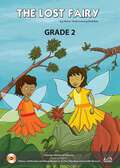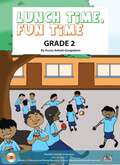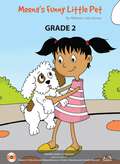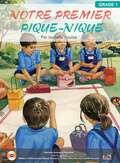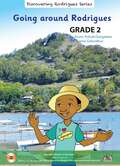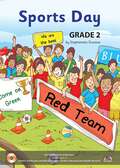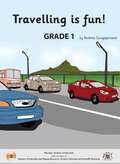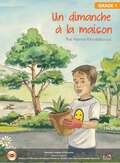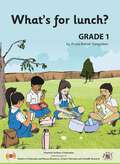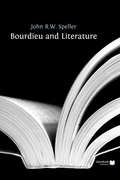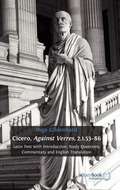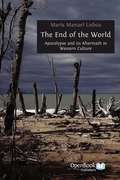- Table View
- List View
Let’s Learn English Part 2 - Pupil's Book class 1 - MIE
by Mauritius Institute of EducationThe Part 2 textbook of "Let’s Learn English" for grade 1 by the Mauritius Institute of Education, under the Ministry of Education, offers a comprehensive framework for English language learning. Organized into six units covering diverse themes like food, transportation, and animals, it intricately blends vocabulary expansion with grammar concepts tailored for young learners. Each unit includes a rich array of activities encompassing listening, speaking, reading, writing, and creative exercises, aiming to nurture holistic language proficiency. Emphasizing the integration of online resources such as YouTube videos, poems, and stories, this textbook serves as a guide for both teachers and students. By outlining clear learning objectives, activities, and assessment methods, it facilitates an immersive English learning experience fostering multi-dimensional skill development.
Let’s Learn English Part-2 - Pupil’s Book class 2 - MIE
by Mauritius Institute of EducationThe English textbook for Grade 2 students in Mauritius, developed by the Mauritius Institute of Education, presents a captivating curriculum in its Table of Contents (Part 2). Units 5 to 8 cover diverse themes including Travel and Journeys, Pets, Gardening, and A World of Dreams and Magic. Students engage in activities ranging from reading, writing, and vocabulary to grammar, phonics, ICT, projects, and stories. Unit 5 delves into transportation, opposites, and Gulliver's travels, while Unit 6 explores various pets, emphasizing care and communication. Gardening, the focus of Unit 7, introduces planting, tools, and animals. Lastly, Unit 8 sparks creativity with imaginative stories and poems, addressing gender, sounds, and wild creatures. Each unit incorporates hands-on activities like crafting, writing notes, and listening to enriching stories, fostering holistic language development for Grade 2 learners.
The Little Red Hen class 2 - MIE
by Mauritius Institute of Education"The Little Red Hen" adapted by the English Department at the Mauritius Institute of Education for Grade 2 presents a classic story of diligence and cooperation. The tale revolves around a resourceful little red hen living on a farm, seeking assistance from her friends—a dog, a cat, and a duck—in various tasks from planting seeds to baking bread. However, each time she asks for help, her friends decline, preoccupied with their own pursuits. Undeterred, the hen independently tends to the chores, culminating in baking a loaf of bread, which she then chooses to enjoy alone. Through engaging illustrations and simple narrative, the story underscores the values of hard work, self-reliance, and the consequences of not lending a hand. The book, designed for interactive classroom sessions, encourages critical thinking among young readers by prompting discussions on sharing, teamwork, and the importance of helping others, fostering essential literacy skills and moral understanding among Grade 2 students.
The Lost Fairy class 2 - MIE
by Helina Hookoomsing-Dookhee"The Lost Fairy," penned by Hélina Hookoomsing Dookhee, spins a tale about two playful fairies, Shaylee and Shayla, frolicking in the woods until they doze off in an empty bird's nest. When Shaylee awakens, she finds herself alone and sets off on a quest to find her missing sister, encountering various woodland creatures along the way. Shaylee's search involves questioning a butterfly, a rabbit, a gnome, and even a little witch, all yielding no success until a perceptive little boy helps reunite the sisters. It turns out Shayla was hiding and following Shaylee all along. The story culminates in a heartfelt moment of reconciliation as Shayla apologizes for causing worry, promising not to hide again. Through enchanting illustrations and engaging narrative, this big book not only captures the adventure of the two fairies but also imparts lessons about companionship, honesty, and the joy of reunion, making it an ideal literary tool for Grade 2 English sessions, fostering comprehension and storytelling skills among young readers.
Lunch Time, Fun Time class 2 - MIE
by Aruna Ankiah Gangadeen"Lunch Time, Fun Time" is a captivating big book designed for Grade 2 English sessions, aiming to enhance literacy skills in young learners. Authored by Dr. Aruna Ankiah-Gangadeen and illustrated by a team, the book features a rhythmic and engaging story reflecting the joyous moments of a school lunch break. It vividly portrays children relishing their meals, engaging in playful activities, sharing stories, and enjoying camaraderie. Through lively illustrations and simple, repetitive text, the book encourages interactive sessions in three stages: pre-reading, reading, and post-reading activities. Teachers are guided to stimulate discussions, encourage predictions, and reinforce comprehension through questions and creative tasks. With its thematic link to Grade 2 English curriculum units, this big book serves as a valuable resource, fostering not only language development but also a deeper interest in English learning among young pupils.
Meena's Furry Little Pet class 2 - MIE
by Melanie Julia Annea"Meena’s Furry Little Pet" is an engaging big book tailored for Grade 2 English sessions, authored by Melanie Julia Annea and illustrated by Crishma Uckiah and Vedita Jokhun. The story revolves around Meena and her playful pet dog, Fluffy. Meena engages in a spirited game of hide and seek with Fluffy, searching in various places around the house until discovering Fluffy happily playing in the garden. However, when Fluffy gets dirty, Meena attempts to give it a bath, only to meet with resistance from the pet. Despite her efforts, Fluffy manages to stay clean by unexpectedly running into the water from her father's watering can. The story unfolds with humor and playful interactions between Meena and her furry pet, highlighting the simple joys and challenges of caring for a pet. The book's interactive sessions aim to enhance comprehension and vocabulary while encouraging creative activities for young learners, making the English learning experience enjoyable and enriching.
Notre Premier Pique-Nique class 1 - MIE
by Par Isabelle Louise"Notre Premier Pique-Nique" présente une histoire captivante centrée autour d'une expérience de pique-nique pour les jeunes élèves. Lors de cette aventure, les enfants se dirigent vers un parc voisin de leur école, accompagnés de leur enseignante, Miss Dina. Installés pour le goûter, ils partagent leurs provisions et découvrent ce que chacun a apporté. Miss Dina montre ses achats, soulignant ainsi l'aspect convivial du moment. Après le goûter, les enfants sont laissés libres pour jouer. Cependant, le temps passe vite et le retour en classe est annoncé avec l'arrivée du van. Ce livre engage les élèves dans une exploration interactive du vocabulaire et des activités associées aux pique-niques, tout en incitant à partager leurs expériences personnelles. Il vise à développer leur compréhension du récit tout en suscitant leur intérêt pour les moments de partage en plein air.
Our Environment class 2 - MIE
by Aruna Ankiah-Gangadeen Seema Goburdhun"Our Environment" is a vibrant big book designed for Grade 2 English sessions, authored by Dr. Aruna Ankiah-Gangadeen and Dr. Seema Goburdhun, featuring illustrations by Kunal Sumbhoo. The book celebrates the diverse natural landscapes of Mauritius, engaging young learners with picturesque descriptions of prominent mountains like Le Pouce, Lion, Signal, Le Morne, and Pieter Both, along with other notable geographical features such as Candos Hill, Macchabee forest, and Grand River South East. Through vivid imagery and simple text, the book introduces students to the rich environmental elements of the island, fostering awareness and appreciation for their surroundings. The interactive sessions encompass pre-reading discussions, focused readings with vocabulary reinforcement, and post-reading activities aimed at enhancing comprehension and encouraging creativity. Seamlessly integrated with the curriculum, this big book serves as an educational tool to instill a sense of pride and belonging while nurturing English language skills among young learners within the context of their local environment.
Our Festivals class 2 - MIE
by Aruna Ankiah-Gangadeen Seema Goburdhun"Our Festivals" is an illuminating big book crafted for Grade 2 English sessions, co-authored by Dr. Aruna Ankiah-Gangadeen and Dr. Seema Goburdhun, with illustrations by Kunal Sumbhoo and Kamla Ernest. The book vividly explores the cultural tapestry of Mauritius through its diverse celebrations. It introduces young learners to the essence of various festivals like Christmas, Divali, Eid, the Spring festival, Cavadee, Ugadi, and Ganesh Chaturthi, offering glimpses into the traditions and customs associated with each occasion. Through simple yet engaging descriptions and colorful illustrations, the book invites children to delve into the festive spirit, emphasizing the significance of rituals, prayers, new attire, sharing of treats, and gathering with family during these special times. Integrated into literacy sessions, the book fosters cultural awareness, language development, and understanding among students, encouraging participation through pre, during, and post-reading activities tailored to reinforce comprehension and creative expression. This educational resource not only enriches English language skills but also instills pride and appreciation for the rich tapestry of festivals within Mauritius' multicultural landscape.
The People of Mauritius class 2 - MIE
by Aruna AnkiahGangadeen Seema Goburdhun"The People of Mauritius," part of the Literacy Pack curated by the Mauritius Institute of Education for Grade 2, presents a culturally enriching exploration of the island's diverse heritage. Through engaging storytelling and vibrant illustrations, the book delves into the ancestral origins of Mauritian people, showcasing the multicultural tapestry woven over generations. The narrative highlights how the great grandparents of different individuals hailed from various countries like India, Africa, China, and France, illustrating the amalgamation of different ethnicities within the Mauritian population. It aims to instill a sense of pride and belonging in young readers by celebrating the country's multiculturalism and emphasizing the importance of friendship and harmony among people from diverse backgrounds. The session activities included foster an interactive learning environment, encouraging discussions about ancestral roots, the significance of cultural diversity, and the value of friendship in a multiethnic society, reinforcing essential literacy skills and cultural understanding among Grade 2 learners.
Sports Day class 2 - MIE
by Stephanette Ducasse"Sports Day," a vibrant big book by Stephanette Ducasse, captures the spirited atmosphere at Happy Kids School during their annual sports event. The narrative unfolds as students participate in various lively activities and races, cheered on by enthusiastic parents and teachers. From the rabbit-race to the clothing-relay, potato-race, and more, each grade level engages in different games, fostering an air of excitement and camaraderie. As the day progresses, the anticipation heightens until the sports-teacher finally announces the victorious Red Team, igniting cheers and applause among the participants. With engaging illustrations and a dynamic storyline, this book not only celebrates the joy of sports but also encourages young readers to embrace teamwork, sportsmanship, and the thrill of competition in a school setting. Through its interactive sessions and activities, the book aims to enhance literacy skills while relaying the fun and energy of Sports Day at the school.
Travelling Is Fun! class 1 - MIE
by Reshma Gungapersand"Travelling Is Fun!" unfolds the adventures of Ben, as he embarks on a journey to the airport. En route, he eagerly observes a vibrant array of vehicles, from a big red bus to motorcycles and bicycles, delighting in the unique experiences each mode of transport offers. Upon reaching the airport, Ben's excitement soars as he witnesses the swift flight of an airplane, dreaming of his upcoming journey high in the sky to England. In England, he anticipates the thrill of train travel, weaving in and out of stations, sparking his excitement even further. Through engaging illustrations and simple yet descriptive language, the book captures the allure of travel, igniting a sense of adventure and discovery in young readers.
Un Dimanche à la Maison class 1 - MIE
by Par Hanna Khodabocus"Un Dimanche à la Maison" présente une journée dans la vie de Kevin, un jeune garçon, et de sa famille lors d'un dimanche ordinaire. Le récit débute par les salutations matinales de Kevin à sa mère et sa famille avant de commencer sa journée. Il décrit sa routine quotidienne, partageant ses moments passés avec son frère, sa sœur, son père devant la télévision, et avec son grand-père dans le jardin. Pendant ce temps, sa grand-mère et sa mère se reposent sur la terrasse. Le livre souligne les activités familiales, les interactions et les responsabilités quotidiennes tout en mettant en avant les moments de détente et de partage. À la fin de cette journée, Kevin se prépare pour la rentrée scolaire du lendemain. Ce livre, conçu pour les jeunes lecteurs, offre un aperçu de la vie domestique typique d'une famille, encourageant les enfants à identifier et à comprendre les activités quotidiennes et les relations familiales.
What’s for lunch? class 1 - MIE
by Aruna Ankiah Gangadeen"What's for Lunch?" invites Grade 1 readers into a delightful lunchtime scene with Ben and his friends. As the bell rings, signaling lunch, the children eagerly gather under a tree, unpacking their lunch bags filled with delectable treats. Excitement fills the air as they share their delicious meals – from Ben's favorite sausage and lettuce sandwich to Sara's crispy chips with ketchup, Rishi's flavorful fried rice with vegetables and chicken, and Anna's tempting chocolate cake, generously offered to her friends. Through engaging illustrations and simple language, the book captures the joy of mealtime and sharing, fostering discussions among young readers about their own lunch preferences and the importance of sharing and expressing gratitude.
Bourdieu and Literature
by John R.W. SpellerBourdieu and Literature is a wide-ranging, rigorous and accessible introduction to the relationship between Pierre Bourdieu's work and literary studies. It provides a comprehensive overview and critical assessment of his contributions to literary theory and his thinking about authors and literary works. <p><p> One of the foremost French intellectuals of the post-war era, Bourdieu has become a standard point of reference in the fields of anthropology, linguistics, art history, cultural studies, politics, and sociology, but his longstanding interest in literature has often been overlooked. This study explores the impact of literature on Bourdieu's intellectual itinerary, and how his literary understanding intersected with his sociological theory and thinking about cultural policy. <p> This is the first full-length study of Bourdieu's work on literature in English, and it provides an invaluable resource for students and scholars of literary studies, cultural theory and sociology.
Cicero, Against Verres, 2.1.53–86: Latin Text With Introduction, Study Questions, Commentary And English Translations
by Ingo GildenhardLooting, despoiling temples, attempted rape and judicial murder: these are just some of the themes of this classic piece of writing by one of the world’s greatest orators. This particular passage is from the second book of Cicero’s Speeches against Verres, who was a former Roman magistrate on trial for serious misconduct. Cicero presents the lurid details of Verres’ alleged crimes in exquisite and sophisticated prose. <p><p> This volume provides a portion of the original text of Cicero’s speech in Latin, a detailed commentary, study aids, and a translation. As a literary artefact, the speech gives us insight into how the supreme master of Latin eloquence developed what we would now call rhetorical "spin". As an historical document, it provides a window into the dark underbelly of Rome’s imperial expansion and exploitation of the Near East. <p> Ingo Gildenhard’s illuminating commentary on this A-Level set text will be of particular interest to students of Latin at both high school and undergraduate level. It will also be a valuable resource to Latin teachers and to anyone interested in Cicero, language and rhetoric, and the legal culture of Ancient Rome.
The End of The World: Apocalypse And Its Aftermath In Western Culture
by Maria Manuel LisboaOur fear of the world ending, like our fear of the dark, is ancient, deep-seated and perennial. It crosses boundaries of space and time, recurs in all human communities and finds expression in every aspect of cultural production - from pre-historic cave paintings to high-tech computer games. This volume examines historical and imaginary scenarios of apocalypse, the depiction of its likely triggers, and imagined landscapes in the aftermath of global destruction. Its discussion moves effortlessly from classic novels including Aldous Huxley's Brave New World, George Orwell's Nineteen Eighty-Four and Margaret Atwood's Oryx and Crake, to blockbuster films such as Blade Runner, Armageddon and Invasion of the Body Snatchers. Lisboa also takes into account religious doctrine, scientific research and the visual arts to create a penetrating, multi-disciplinary study that provides profound insight into one of Western culture's most fascinating and enduring preoccupations.
How to Read a Folktale: The 'Ibonia' Epic from Madagascar
by Lee HaringHow to Read a Folktale offers the first English translation of Ibonia, a spellbinding tale of old Madagascar. Ibonia is a folktale on epic scale. Much of its plot sounds familiar: a powerful royal hero attempts to rescue his betrothed from an evil adversary and, after a series of tests and duels, he and his lover are joyfully united with a marriage that affirms the royal lineage. These fairytale elements link Ibonia with European folktales, but the tale is still very much a product of Madagascar. It contains African-style praise poetry for the hero; it presents Indonesian-style riddles and poems; and it inflates the form of folktale into epic proportions. Recorded when the Malagasy people were experiencing European contact for the first time, Ibonia proclaims the power of the ancestors against the foreigner. <p><p> Through Ibonia, Lee Haring expertly helps readers to understand the very nature of folktales. His definitive translation, originally published in 1994, has now been fully revised to emphasize its poetic qualities, while his new introduction and detailed notes give insight into the fascinating imagination and symbols of the Malagasy. Haring’s research connects this exotic narrative with fundamental questions not only of anthropology but also of literary criticism.
Jane Austen: Reflections of a Reader
by By Nora Bartlett. Edited by Jane StablerThis volume presents an exhilarating and insightful collection of essays on Jane Austen – distilling the author’s deep understanding and appreciation of Austen’s works across a lifetime. The volume is both intra- and inter-textual in focus, ranging from perceptive analysis of individual scenes to the exploration of motifs across Austen’s fiction.
The Life and Letters of William Sharp and "Fiona Macleod". Volume 2: 1895-1899
by William F. HalloranWilliam Sharp (1855-1905) conducted one of the most audacious literary deceptions of his or any time. Sharp was a Scottish poet, novelist, biographer and editor who in 1893 began to write critically and commercially successful books under the name Fiona Macleod. This was far more than just a pseudonym: he corresponded as Macleod, enlisting his sister to provide the handwriting and address, and for more than a decade "Fiona Macleod" duped not only the general public but such literary luminaries as William Butler Yeats and, in America, E. C. Stedman. <p><p> Sharp wrote "I feel another self within me now more than ever; it is as if I were possessed by a spirit who must speak out". This three-volume collection brings together Sharp’s own correspondence – a fascinating trove in its own right, by a Victorian man of letters who was on intimate terms with writers including Dante Gabriel Rossetti, Walter Pater, and George Meredith – and the Fiona Macleod letters, which bring to life Sharp’s intriguing "second self". <p> With an introduction and detailed notes by William F. Halloran, this richly rewarding collection offers a wonderful insight into the literary landscape of the time, while also investigating a strange and underappreciated phenomenon of late-nineteenth-century English literature. It is essential for scholars of the period, and it is an illuminating read for anyone interested in authorship and identity.
The Living Stream: Yeats Annual No. 18
by Warwick GouldYeats Annual No. 18 is another special issue in this renowned research-level series offering a tribute to the pioneering Yeats scholar, A. Norman Jeffares. <p><p> Memories of the man are shared by Seamus Heaney, Christopher Rush and Colin Smythe, who compiles a bibliography of Jeffares’s work. Terence Brown, Neil Corcoran, Warwick Gould, Joseph M. Hassett, Phillip L. Marcus, Ann Saddlemyer, Ronald Schuchard, Deirdre Toomey and Helen Vendler offer essays on such topics as Yeats and the Colours of Poetry, Yeats’s Shakespeare, Yeats and Seamus Heaney, Lacrimae Rerum and Tragic Joy, Raftery’s work on Yeats’s Thoor Ballylee, Edmund Dulac’s portrait of Mrs George Yeats, The Tower as an anti-Modernist monument, with close studies of ‘Vacillation’, ‘Her Triumph’, and ‘The Cold Heaven’. <p> Throughout, the essays are inflected with memories of Jeffares and his critical methods. The volume is rounded with further essays on A Vision by Neil Mann and Matthew de Forrest, while reviews of recent editions and studies are provided by Matthew Campbell, Wayne K. Chapman, Sandra Clark, Denis Donoghue, Nicholas Grene, Joseph M. Hassett, and K.P.S. Jochum.
Oral Literature in the Digital Age
by Mark Turin Claire Wheeler and Eleanor WilkinsonThanks to ever-greater digital connectivity, interest in oral traditions has grown beyond that of researcher and research subject to include a widening pool of global users. When new publics consume, manipulate and connect with field recordings and digital cultural archives, their involvement raises important practical and ethical questions. This volume explores the political repercussions of studying marginalised languages; the role of online tools in ensuring responsible access to sensitive cultural materials; and ways of ensuring that when digital documents are created, they are not fossilized as a consequence of being archived. Fieldwork reports by linguists and anthropologists in three continents provide concrete examples of overcoming barriers—ethical, practical and conceptual—in digital documentation projects. Oral Literature in the Digital Age is an essential guide and handbook for ethnographers, field linguists, community activists, curators, archivists, librarians, and all who connect with indigenous communities in order to document and preserve oral traditions.
Storytelling in Northern Zambia
by Robert CancelMore than just a book, Storytelling in Northern Zambia lets you watch videos of the storytellers while you read. Storytelling plays an important part in the vibrant cultural life of Zambia and in many other communities across Africa. This innovative book provides a collection and analysis of oral narrative traditions as practiced by five Bemba-speaking ethnic groups in Zambia. The integration of newly digitalised audio and video recordings into the text enables the reader to encounter the storytellers themselves and hear their narratives as they were recounted during Robert Cancel’s research trips to Zambia. Robert Cancel's thorough critical interpretation, combined with these newly digitalised audio and video materials, makes Storytelling in Northern Zambia a much needed addition to the slender corpus of African folklore studies that deal with storytelling performance. Cancel threads his way between the complex demands of African fieldwork studies, folklore theory, narrative modes, reflexive description and simple documentation and succeeds in bringing to the reader a set of performers and their performances that are vivid, varied and instructive. He illustrates this living narrative tradition with a wide range of examples, and highlights the social status of narrators and the complex local identities that are at play. Cancel’s innovative study tells us not only about storytelling but sheds light on the study of oral literatures throughout Africa and beyond. Its innovative format, meanwhile, explores new directions in the integration of primary source material into scholarly texts. This book is part of our World Oral Literature Series in conjunction with the World Oral Literature Project.


